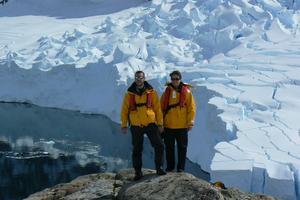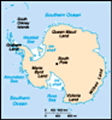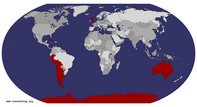Advertisement
Published: December 23rd 2006

 Dreams come true
Dreams come true
Dave and Claire at Neko Harbour in the Antarctic Peninsula on one of the few sunny daysWe turned south out of the calm waters of the Beagle Channel — and we are in the Drake Passage, on our way to the Antarctic Peninsula.
How can one describe the Antarctic? Words are inadequate, and photos don't come close to capturing the grandeur of the environment. So, this must suffice as rough sketches from our trip, four days on the Drake Passage and five days cruising the protected waters of the Antarctic Peninsula.
On board with us on the MV Akademic Shokalskiy with us were the 24 Russian crew, an expedition staff of people who have worked or adventured in the polar regions, and 46 other tourists.
The fabled Drake is named after the English explorer and pirate, and has traditionally been feared by sailors for its wild seas, where winds and waves can circle the planet without being blocked by land. It took the Shokalskiy two days to cross the Drake. On the way south, we were lucky to have pretty calm waters: not calm enough for many of the passengers, who were laid flat for the entire crossing. Returning north was much more exciting, with 6m waves for part of the second day that
had the poor galley staff chasing food and crockery around the kitchen and dining room, and the ship's doc doing cabin visits to administer to the ill. (Luckily, we weren't among them.)
However, the Drake also gave us fantastic birdwatching. We felt priviledged to see a wandering albatross. It is easy to understand their almost mythical status among sailors (and poets), as we watched the huge bird glide with such graceful ease among the waves. This albatross has a wingspan of up to 3m, and can fly many hundreds of kilometres in a day.
The albatrosses are members of the order of birds known colloquially as tubenoses (and in zoology as procellariiformes), which also includes petrels, fulmars, shearwaters and prions. Many of the them can only fly in areas where strong winds blow. The wanderer dwarfed some of the other tubenoses that followed the ship across the Drake. The most common was probably the pintado petrels, which dipped and waved in graceful choreography about each other. There were also many black-browed albatrosses, another beautfil bird. Claire's second favourite was the light-mantled sooty albatross with is dove-like colouring.
19 of the 21 species of albatrosses are threatened with

 Waiting to go ashore
Waiting to go ashore
It was snowing a little as we prepared for our first landing, at Devil Islandextinction, mostly due to long-line fishing. They get caught by hooks in the bait and are drowned. A fishing line 90km long may contain 10,000 hooks. About 100,000 birds are killed a year. The sheer number of deaths is compounded by the albatrosses' life cycles. Andy, one of the naturalists on board, told us that as many albatrosses breed only every second year, the birds are being killed faster than they can reproduce. There are ways for the commercial fishers to reduce birdkills, but they don't seem to be very interested in doing so. For more about this awful devastation, check out this web site on
saving the albatrosses.
We also spotted fin whales in the passage, and saw penguins porpoising through the waters, chasing food. We came across minke whales three times, including one day during a cruise around icebergs in Zodiacs (rubber dinghies with outboard motors), when they surfaced near us. This happened when we had barely got over the excitement of seeing a pod of three orcas surfacing among us, and only about a metre from one of the Zodiacs. The expedition team collected our photos to send to a New Zealand-based orca database, which makes use unique
markings to track individual animals as an aid to orca research. Being so close to them and almost at water level kept everyone talking over the experience until well into the night.
We were given free access to the decks and some other parts of the ship. Other than the decks and the bar one of the most popular places was the bridge, where we could observe sealife while staying out of the cold wind.
It was also a good place to keep an eye on the radar for the first iceberg, and to observe the captain and his crew navigating the ship between massive icebergs. The first floating ice, tabular icebergs, appeared as we left the Drake in the evening to sail past the South Shetland Islands into the Bransfield Strait.
Tabular icebergs are bits of ice that have broken off the sea ice that forms around the continent in winter. The other way in which icebergs are formed is when glaciars calve. The icebergs are shaped by wind and sea into wildly fantastical shapes with beautiful blues and greens being reflected as the ice gets older and denser. One danger with the free-floating icegergs is
that as they are melted underneath by the ocean water (which is often warmer than the air in summer) and wave action, the distribution of their weight changes and they can turn without warning. We had two cruises around icebergs in kayaks and Zodiacs. During the first, in aptly named Paradise Bay, we had to keep a respectful distance. During the second, the icebergs had grounded on the seabed and it was considered safe to get almost within arm's length.
The landscape was wildly beautiful and inhospitable, and at the same often had an ethereal, fairytale quality. Even standing in it, the vista is so huge it is sometimes impossible to comprehend the scale of the mountains and glaciers surrounding us. Were those ice cliffs 20m high, or 200? Some of them seemed small and delicate in the landscape, but we knew, from Christoff, the glaciologist on board, that even the small ones often contained ice that is tens of thousands of years old (great with some single malt!) and we saw ourselves icebergs that had calved off them, as large as a block of flats tiny in the seas beneath them. Sometimes our ship, a refurbish Russian research

 On Devil Island
On Devil Island
Dave against a background of glaciar, and sea-ice breaking upvessel, the Zodiac dinghies or two-person kayaks put the scene in perspective. Perhaps this amazing fact, provided by Christoff, helps to give some perspective: 90% of the fresh water found on the planet is in Antarctica. (By comparison, all the rivers and lakes of the world provide only 0.6% of the world's fresh water. Most of the remaining amount is in the Greenland ice-cap.) We had many days of white-on-white scenery, very beautiful and delicate, but there were also lovely colours: seas of deep ultramarine, steel or phthalo green, ice blues and greens, cobalt skies, and of course the colours of the animals and birds, the vivid lichens, and the rock.
Kirsten, the expedition leader, put the tourists in charge of the weather. She complimented us on our lousy job — much fog, mostly grey skies, some snow and sleet, and very little blue and sunshine — but we more than made up for it with the variety wildlife, which was also our job.
The spectacular sightings included a leopard seal, which some people heard singing in its sleep on an ice floe. Kirsten was particularly excited: she has worked for years in the polar regions and this,

 On the beach, Devil Island
On the beach, Devil Island
Cape Well-Met looms behindshe told us, was a rare thing for humans to witness. We were also treated to the sight of a juvenile elephant seal, and several crabeater and Weddel seals.
Of course, it wouldn't be the Antarctic without penguins. We made at least two shore landings every day, and at most places we met with Adélie, gentoo or chinstrap penguins. Apart from enjoying panoramic views (as well as frozen extremities and the occasional katabatic wind), one of our favourite things to do was to sit and watch the penguins go about their normal business. On land, we found them comical to watch as they waddled along, hopping onto rocks, and belly sliding when a snowy slope was steep enough — but once they were in the water they were all glide and grace. The adults were sitting on eggs when we were there, with chicks expected to start hatching in the following couple of weeks. Nesting time included collecting pebbles for the nests, the preferred method being to steal them from inattentive neighbours. Juveniles seemed to loiter in groups at the edges of the rookery. Those going back to the sea to feed (parents take it in turns to sit
on the egg, releasing the other to feed) would gather in procrastinating groups, each wanting to be in the middle of the group when it finally took to the water, in the hope of avoiding the fate of becoming dinner for waiting leopard seals. The penguins seem to be as curious about humans as we are about them, and would often approach us.
As well as an overdose of wonder, we had our share of humorous moments. One involved our first shore landing, when we faced the prospect of being marooned until the next high tide. After we landed on Devil Island in the Zodiacs the falling tide caused a great deal of pack ice to concentrate around the landing area. When we tried to leave, the Zodiacs kept getting stuck on the ice as there was no longer a passage through it back to our ship. Once it became clear that dragging the dinghies over the unstable ice to the open sea wasn't going to work, we had to find another beach exit. This became known as our Shackleton moment. (Luckily, the survival kit that goes ashore with each landing contains high-fat food!)
Another time, while on
a Zodiac cruise of grounded tabular icebergs, the outboard motor disappeared overboard while the driver was turning a tight circle. The look on his face was priceless. The Zodiacs travel in pairs for safety so we were able to tow the disabled crew back to the ship, picking our way through icebergs, and patches of sea ice that kept moving, closing and opening channels before us.
Some of our landings focused on human activity in the Antarctic. We visited an abandoned whaling station on Deception Island, in the South Shetland Islands. It was quite eerie, with grey skies, biting cold, black volcanic sand, whalebones, rusting machinery and delapidated wooden huts littering the beach. Trevor, the resident historian, told us that at the height of the whaling industry there 3,000 whale carcasses lay on the beach — a poignant reminder of the mass killings that took place. The same bay was also the site of a British Antarctic Survey research station. It got wiped out by volcanic ash and mud following the eruptions in 1967 and 1970. Poking around the old huts was amazing. Some of them still had artefacts from a bygone age just lying around on the floor,
and pointing to the quick exit in 1970. The buildings and contents are protected by a heritage trust and so nothing can be taken from them.
We also stopped at Port Lockroy, an old British Antarctic Survey base which has been
turned into a museum and post office. The base was used to study the earth's ionosphere by way of a complicated electronic machine that required skill and constant attention to operate. The machine operator, who lives in retirement in North Oxfordshire, spends the Antarctic summer at the base. He told us that, when the base was shut down, the remaining anthracite, a form of coal used for heating (along with other useful materials) was locked into a Nissen hut there. When people returned to Port Lockroy they were puzzled to discover that much of the anthracite had disappeared. They discovered its whereabouts pretty soon: it was scattered around the tiny island among the nests of the gentoo penguins that hatch chicks there. The penguins had found a way of breaking into the hut. The old man told us that the gentoos at Port Lockroy have a higher-than-average survival rate, and he speculates that this could be attributed to

 Taking it easy
Taking it easy
Louise, the kayaking leader, and Adélie penguins at Brown Bluff, on the Antarctic continentthe use of anthracite in the nests, as it is dark and absorbs more heat than the local beach pebble which is the usual nest material.
The most southerly point we reached was 65 degrees and 19 minutes south. Then it was time to turn around, weaving our way back through the islands of the Antarctic archipeligo and across the Drake Passage, to Ushuaia and points further north.
Advertisement
Tot: 0.247s; Tpl: 0.018s; cc: 22; qc: 92; dbt: 0.1094s; 1; m:domysql w:travelblog (10.17.0.13); sld: 1;
; mem: 1.3mb





















Monique Bond
non-member comment
happy christmas and an exciting new year
hi Dave and Claire, an overdose of wonder - what an apt description. Thanks for sharing this fabulous experience. The photos were magic and the descriptions made me feel I was there too. Wherever you are for Christmas our thoughts will find you and send you all our best wishes and love. All well here, Graham and Monique